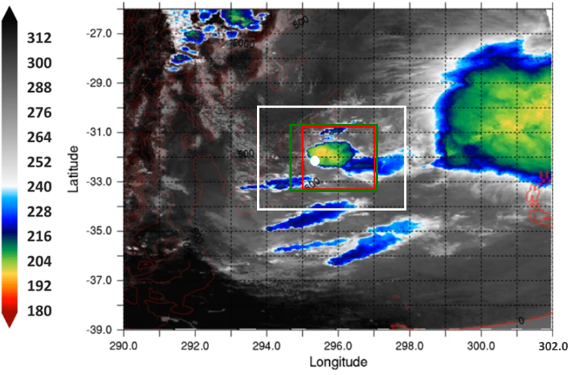Case Description: 23 January 2019
Summary
An intense, organized system is formed from multi-cell interactions
Description
Vigorous convection occurs in less pronounced shear than the prior day. Convective initiation at 14 UTC to the south of the site, while another initiates north of the site at 14:30 that dies out. The southern cell grows and merges at 15:15 with a smaller, trailing cell. A new cell pops up over the site at 16:15 and grows to merge and overtake the growth of the southern system by 17:30. The organized system continues to grow while a smaller cell forms at 17:30 to the northeast of the site and merges with the system by 18:30. Potentially a challenging simulation because of the multi-cell interactions. CAPE values are in the very top third of their ranges (at 15 UTC MUCAPE=3932; MLCAPE=1864 J kg-1).
Available assets
CSAPR2, CSU C-Band data, GOES rapid scan
Unavailable: G1, RELAMPAGO data
Critical period: 14:00–18:00

Figure 8 GOES16 band 13 brightness temperature at 2019-01-23 at 17:30 UTC. An intense, organized system over the site, which resulted from the merging of two systems. Another cell is developing to the northeast of the site that later merges with the system.
Available LES ensemble members
Impression |
Ensemble Member |
Cloud Behavior |
|---|---|---|
Eh |
EDA05 |
Initiation lags 2 h and has poor morphology–overdevelops to some extent. |
Bust |
EA05-Morr |
Unobserved extensive convection to the northeast of the domain with far saller convective cells within the domain than observed. The pre-storm environment in the 6-12 UTC period simulated by D3 gets a giant MCS to the north that is misplaced and sticks around too long, which then disrupts development of the later systems near the AMF that we want to simulate. |
Bust |
EDA07-Morr |
No convective initiation south, north, or over the AMF. The southern cell advects in versus being initiated. et a similar pattern of convection at 18:30 UTC, but it is the right answer for the wrong reason. |